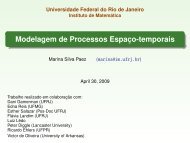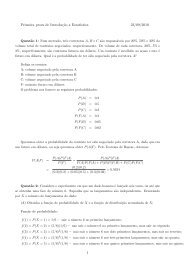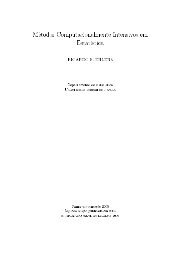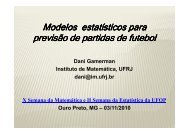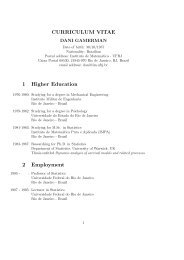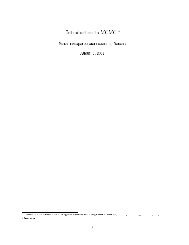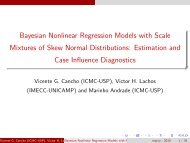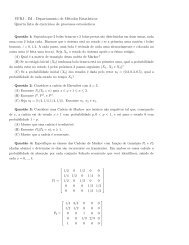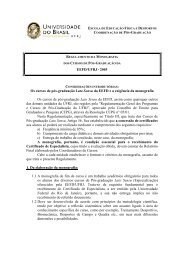Copulas: a Review and Recent Developments (2007)
Copulas: a Review and Recent Developments (2007)
Copulas: a Review and Recent Developments (2007)
You also want an ePaper? Increase the reach of your titles
YUMPU automatically turns print PDFs into web optimized ePapers that Google loves.
2 Extended copula conceptsIn this section we outline several important new advanced concepts which are importantcontribution into the modern copula theory <strong>and</strong> its application.2.1 Extensions of the probability integral transformHere we will present two recent generalizations of the classical probability integraltransform, i.e. F (X) » U(0; 1), where X is a continuous r<strong>and</strong>om variable withdistribution function F , see Feller (1968).2.1.1 Bivariate probability integral transform <strong>and</strong>related Kendall distribution functionsAn extension of probability integral transform is given by Nelsen et al. (2001a). Topresent it we need the following de¯nition.De¯nition (distribution function of H 1 given H 2 , Nelsen et al. (2001a)).Let H 1 <strong>and</strong> H 2 be bivariate distribution functions with common continuous marginaldistribution functions F <strong>and</strong> G. LetX <strong>and</strong> Y be r<strong>and</strong>om variables whose joint distributionfunction is H 2 ,<strong>and</strong>let − ®H 1 jH 2 (X; Y ) denote the r<strong>and</strong>om variable H1 (X; Y ).The H 2 -distribution function of H 1 , which we denote (H 1 jH 2 ), is given byµ µ −H1 ® ©(x;(H 1 jH 2 )(t) =P jH 2 (X; Y ) · t = ¹ H2 y) 2 (¡1; 1)2¯¯H 1 (x; y) · t ªfor t 2 [0; 1], where ¹ H2 (:) denotes the measure on (¡1; 1) 2 induced by H 2 .Since copulas are bivariate distribution functions with uniform margins on [0; 1],we have an analogous de¯nition for copulas: If C 1 <strong>and</strong> C 2 are any two ® copulas, <strong>and</strong>if U; V » U(0; 1) whose join distribution function is C 2 ,thenhC 1 jC 2 (U; V ) denotesthe r<strong>and</strong>om variable C 1 (U; V )<strong>and</strong>theC 2 -distribution function of C 1 is given byµ µ −C1 ® ©(u;(C 1 jC 2 )(t) =P jC 2 (U; V ) · t = ¹ C2 v) 2 [0; 1]2¯¯C1 (u; v) · t ªfor t 2 [0; 1], where similarly ¹ C2 (:) denotes the measure on [0; 1] 2 induced by C 2 .The following theorem is a bivariate analog of the probability integral transform.Theorem (bivariate probability integral transform, Nelsen et al. (2001a)).Under the above notations, let C 1 <strong>and</strong> C 2 be the copulas associated to H 1 <strong>and</strong> H 2 .Then (H 1 jH 2 )=(C 1 jC 2 ). ¥In the particular case when C 1 <strong>and</strong> C 2 are represented by min(u; v), independencecopula ¦(u; v) =uv <strong>and</strong> max(u + v ¡ 1; 0), one obtains the distribution of (C 1 jC 2 )(t)listenintheTable1.6



